Introduction
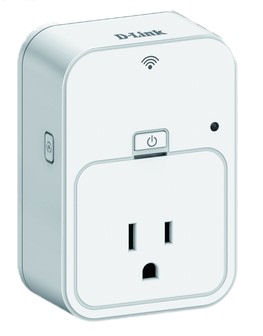
| At a Glance | |
|---|---|
| Product | D-Link DSP-W215 mydlink Wi-Fi Smart Plug [Website] |
| Summary | Wi-Fi enabled power plug features remote control (on/off) of the power plug and monitoring of power consumption. |
| Pros | • Easy to setup (uses WPS) • Sends in-app notifications for scheduled events • Thermal overload protection • Monitor/control energy usage • Power switch on device lets you turn power on/off without using the app. • 5 schedule profiles |
| Cons | • Does not interface with IFTTT • Sunrise/Sunset type schedules not included • No option for randomizing on/off times around a trigger time • No log files • No Web UI or desktop apps – must use smartphone apps |
Home automation seems to be the rage these days. I’ll admit that for being a high tech guy, I haven’t really dived into it. My first experience with HA was with the Belkin WeMo [reviewed]. It’s fair to say that I wasn’t impressed with it and ended up returning the product.
This review will focus on D-Link’s newest entry into the HA market, the DSP-W215 WiFi Smart Plug. Like the WeMo, you control the smart plug remotely with either an iOS or an Android app. With similar power monitoring features as the WeMo and priced at $49.99, the D-Link plug competes directly with the $59.99 power monitoring version of the WeMo.
The D-Link Smart Plug is larger than the Belkin WeMo. Based on the positioning of the wall plug on the unit (shown below), you’ll want to plug the Smart Plug into the top electrical outlet on your wall socket to avoid blocking both sockets.
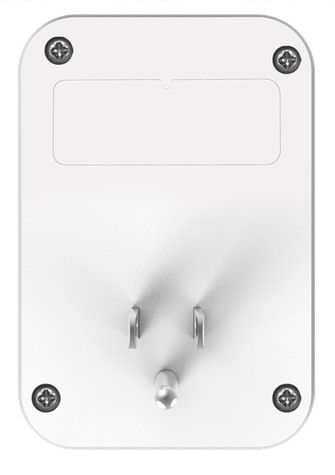
D-Link DSP-W215 rear view
The image below, taken from the online user manual, shows an overview of the hardware and the LED indicators. On the side of the unit, you’ll find the WPS/Reset button. The status indicator, (#3) shows your connectivity status. Solid green indicates that the device has successfully connected to your Wi-Fi network, and is what you want to see. The On/Off button lets you turn the power to the socket on/off without using a smartphone app.
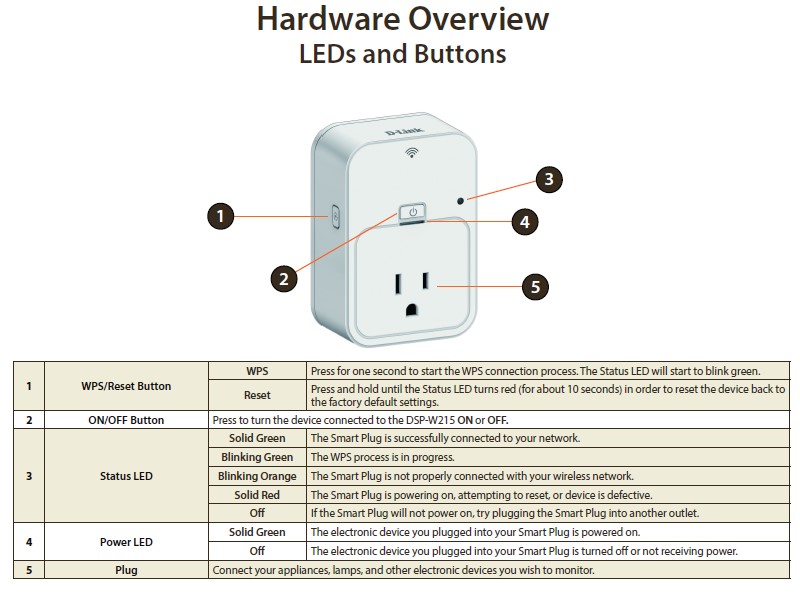
D-Link DSP-W215 hardware overview and callouts
Setup
In order to set up and use the D-Link Smart Plug, you must have the following:
- A Wi-Fi network that’s connected to the internet
- An Android or iOS device
- A “MyDlink” account. If you don’t already have one, you can set up an account for free at www.mydlink.com.
- The Smart Plug app downloaded from Google Play or the Apple App store.
For setup, you need to enable Wi-Fi on your smartphone and connect it to the same network that the Smart Plug will be using. The entire setup process is performed through a wizard that launches the first time that you run the Smart Plug app on your smartphone. You merely plug in the Smart Plug device to a power outlet and run the Smart Plug app on your smartphone.
The most difficult step, and it’s an easy one, is connecting the device to your wireless network. You merely push the WPS (Wi-Fi Protected Setup) button on your router, and the WPS button on the side of the Smart Plug. The status light should change from blinking orange (not connected) to blinking green (WPS connection being established) to solid green in less than two minutes. Typically, a WPS negotiation should be around 30 seconds.
If your router doesn’t support WPS, and virtually all modern routers do, you also have the option of performing a manual network setup using information provided on a printed card that’s included with the product. During the setup process, you name your device (eg, Lamp), and provide login credentials to your MyDlink account.
A couple of notes about the smartphone apps:
- The iOS app is an iPhone app, so if you’re using it on an iPad, you’ll need to orient the iPad vertically.
- The permissions requested by the Android app seemed excessive for the features of the app. Why would an application that communicates with a Smart Plug need access to the Camera/Microphone?
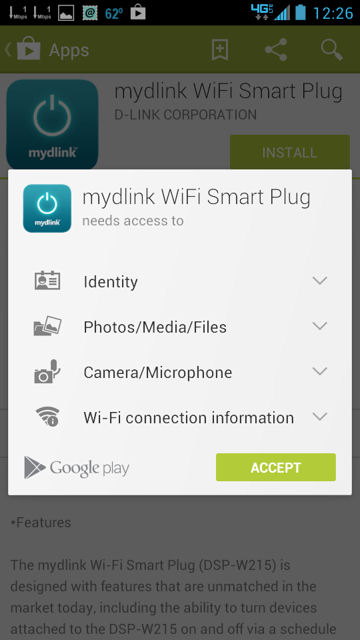
D-Link DSP-W215 Android Permissions Required
Hands On
Once your device has connected to your network and to mydlink.com, you’ll land at the screen shown on the left in the composite image below. This provides a top level status of each of your Smart Plug devices. If you have more than one Smart Plug associated with your mydlink account, each one will appear on this screen.
This screen shows that “Lamp” is currently turned on, the power being supplied to the load that’s plugged in is 49 watts, and the temperature of the Smart Plug is 118 F. The power icon on the left toggles the power on/off. If the plug is turned off, the status disappears and is replaced with “Off”.
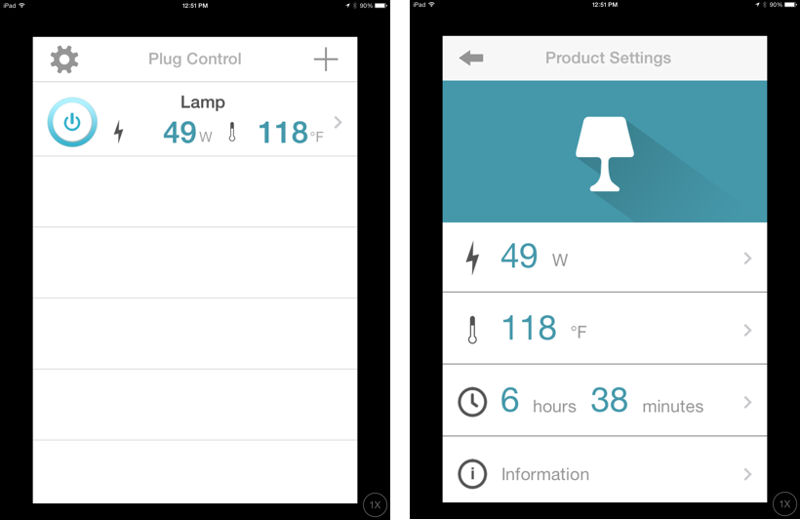
D-Link DSP-W215 landing page and top level menu
If you tap on the right “>” next to the temperature, the screen shown on the right will appear. For this screenshot, I scrolled down so that the four sub menus would be visible. The label for the switch, “Lamp” has scrolled off the top. With a little better design, I would think that everything on this screen should fit on a single screen without scrolling.
I’ll comment on each of the four menus briefly. Be sure to check out the gallery for screenshots from each of the menus.
Power – In this menu, you can create a monthly power budget for the device(s) plugged into the Smart Plug. The chart shows daily power consumption along with a graph showing percentage of the total power budget consumed. Optionally, you can choose to turn off power when the monthly power usage exceeds the limit. You can also choose the day of the month to use for the billing date as well as set a notification warning level.
Temperature -This is a really simple menu. You can enable/disable overheat protection as well as an overheat alert. In this menu, you also set the threshold for turning off power to the socket. It defaults to 158 degrees F.
Schedule – The Smart Plug schedule menu provides you with five schedules. The default names, all of which can be changed are In Home, Away, Customize 1, Customize 2 and Customize 3. Only one profile can be active at a time. Power on/off schedules can be set in half hour increments with multiple on/off times for each day. You can enable/disable reminders to notify you when an event is triggered and set the time zone. Notifications are delivered through the Smart Plug app.
Information – This page provides basic information about your Smart Plug including IP address, MAC address, current firmware version and product name. In this menu, you can change the name of the device, say from “Lamp” to “Floor Lamp” and perform a factory reset. This menu will also notify you of available firmware updates and will download/install the updates for you.
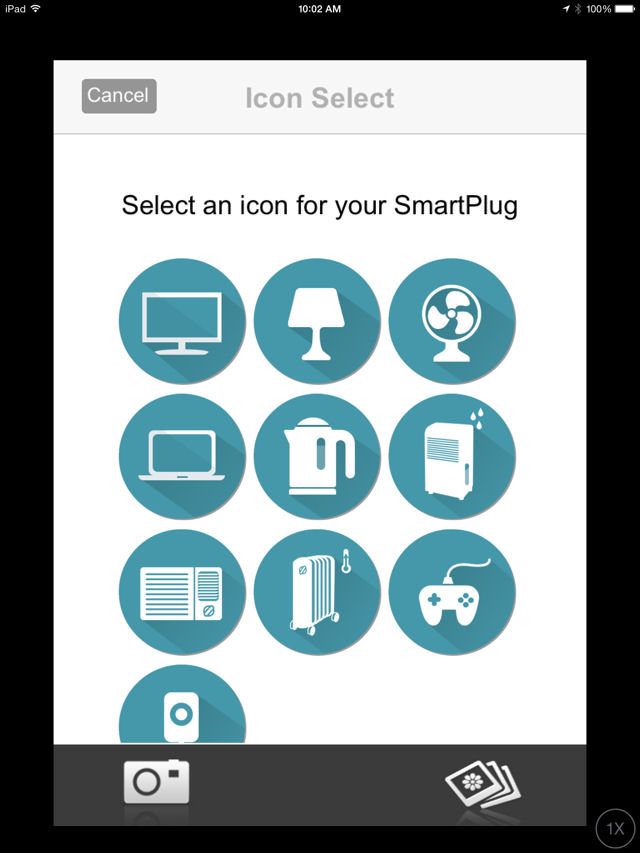
For each device, you can select an icon to represent the Smart Plug
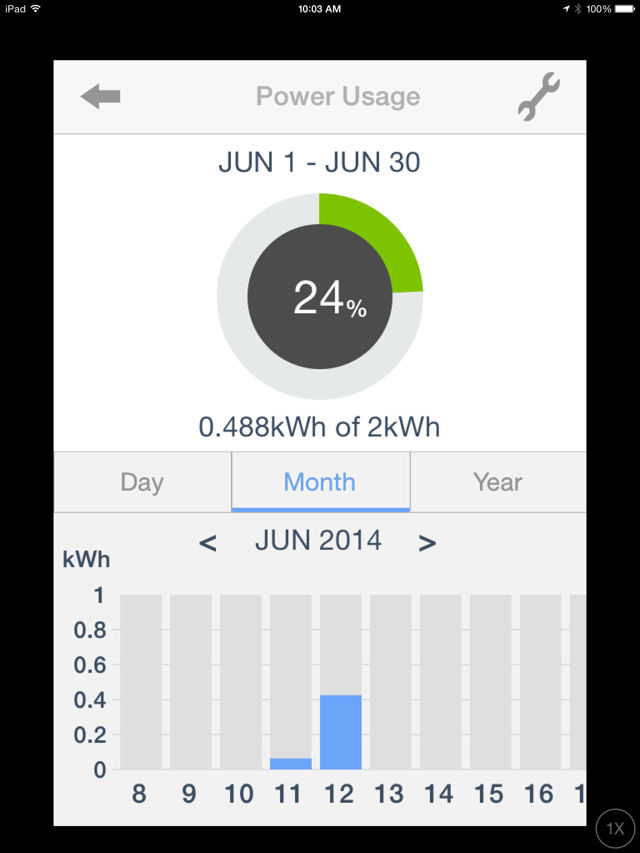
This shows the daily power usage and the total power consumed as a percentage of the budget. I set the level at 2kWh so that the chart would look more meaningful.
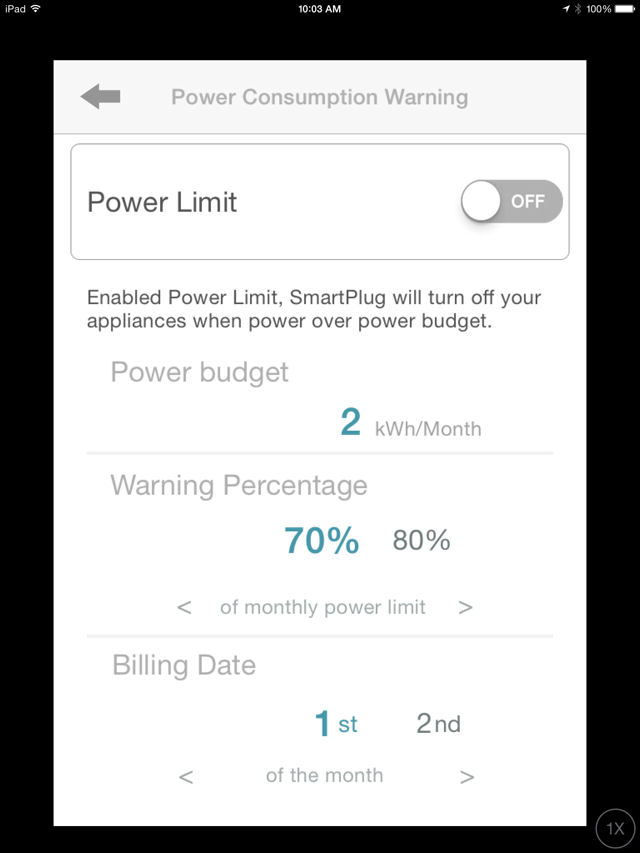
Here you set the monthly power budget, billing date and warning notification. If the power limit is enabled, the plug will be shut down when the budget is exceeded.
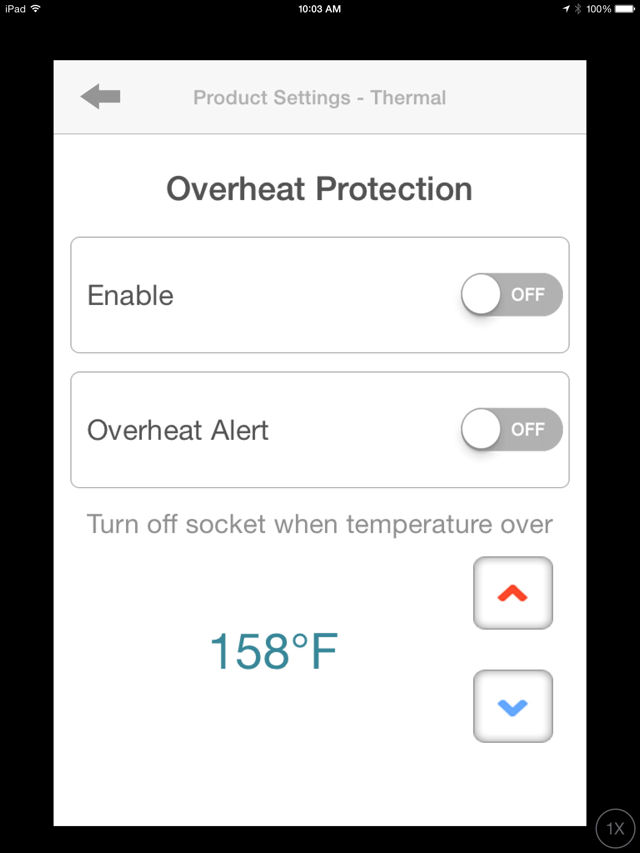
Set temperature threshold and enable/disable overheat protection and alerts.
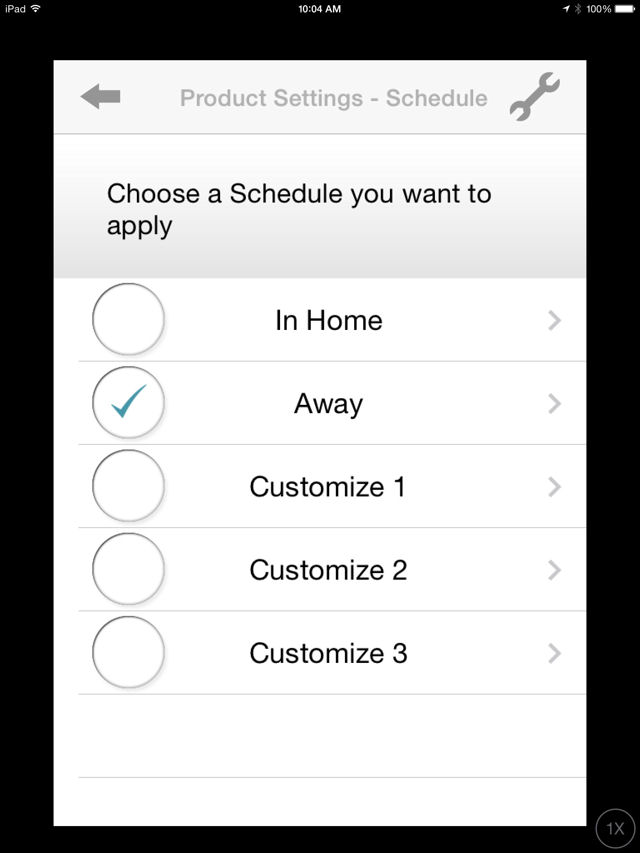
The Smart Plug provides five schedule profiles. Each can be renamed.
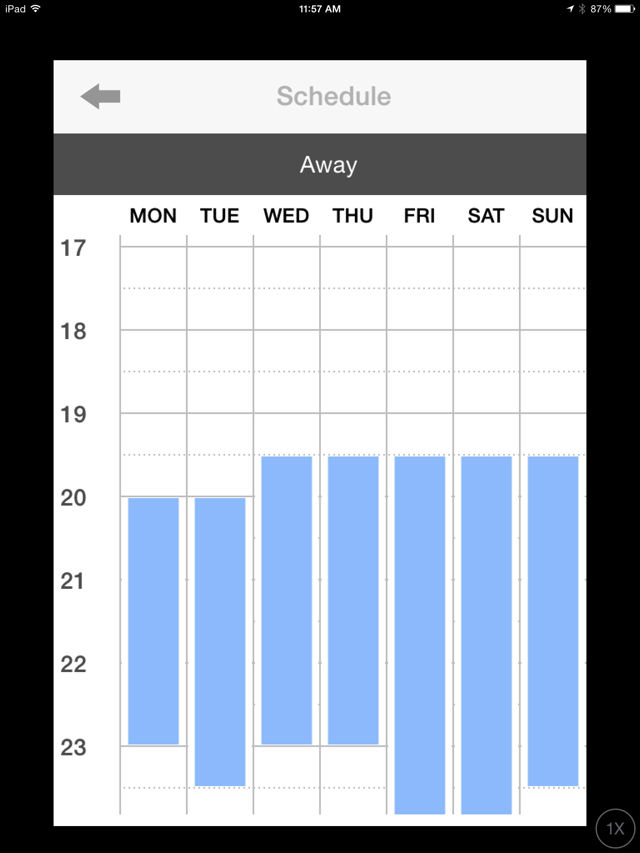
You can set multiple on/off schedules per day. Each block represents 1/2 hour.
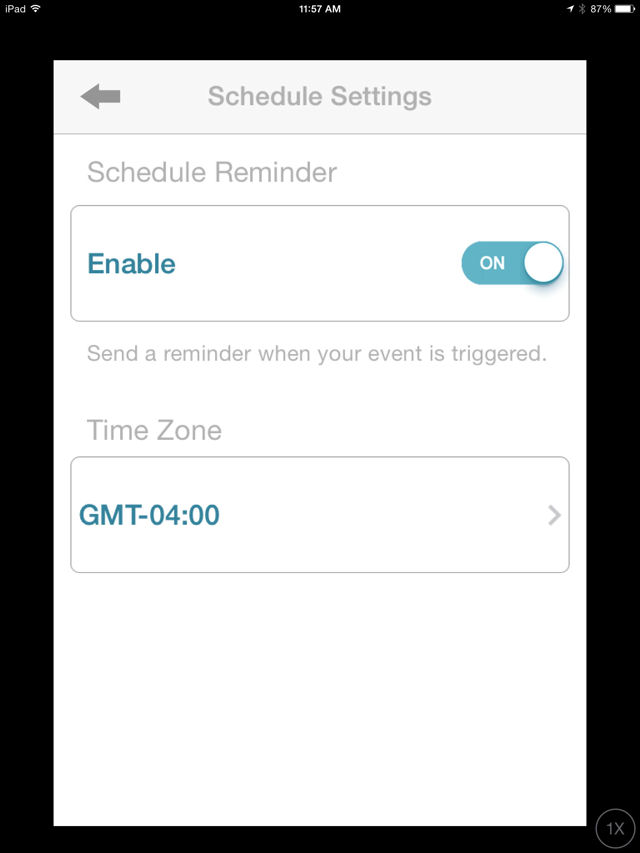
Enable/disable reminders (notifications) and set the time zone.
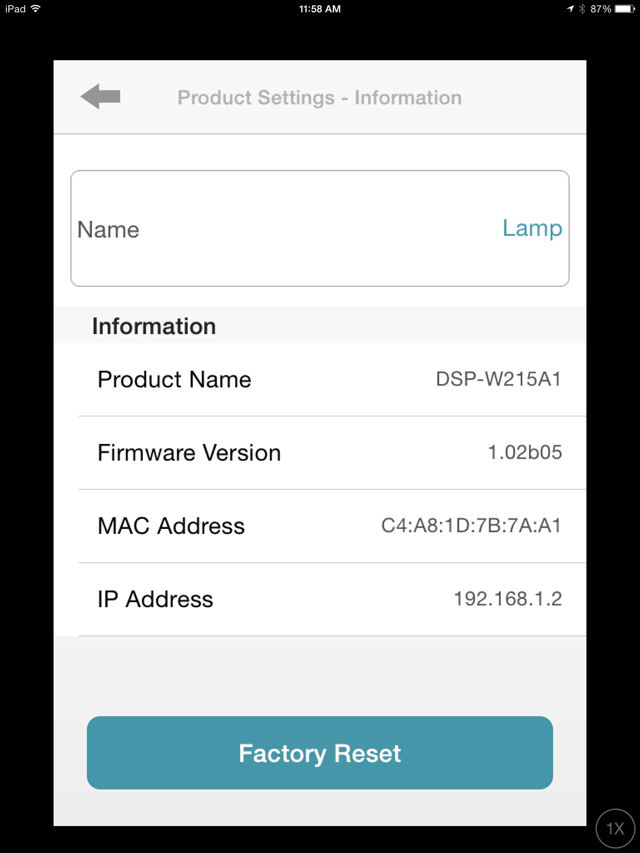
Basic product information is shown here. You can also change the device name or do a factory reset.
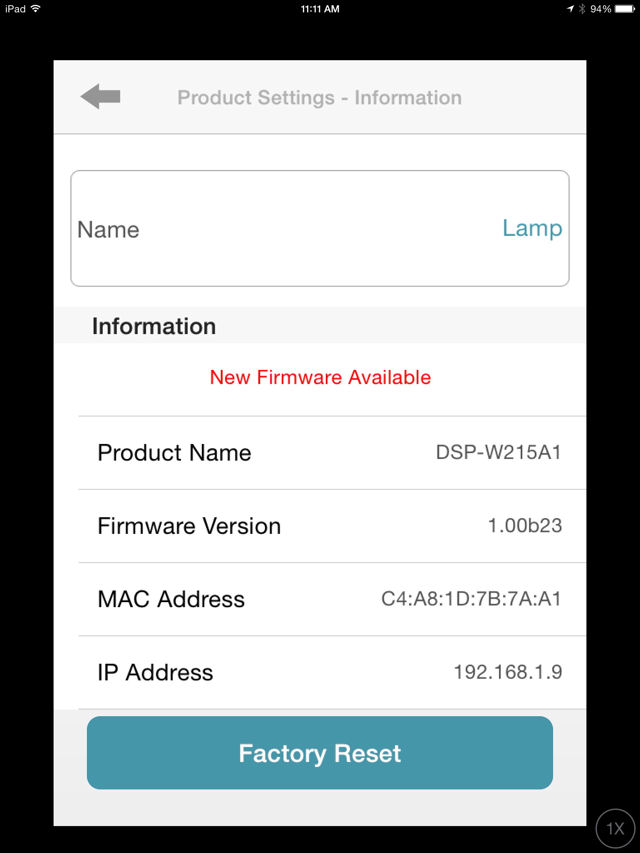
This page is also where you receive notification of available firmware updates
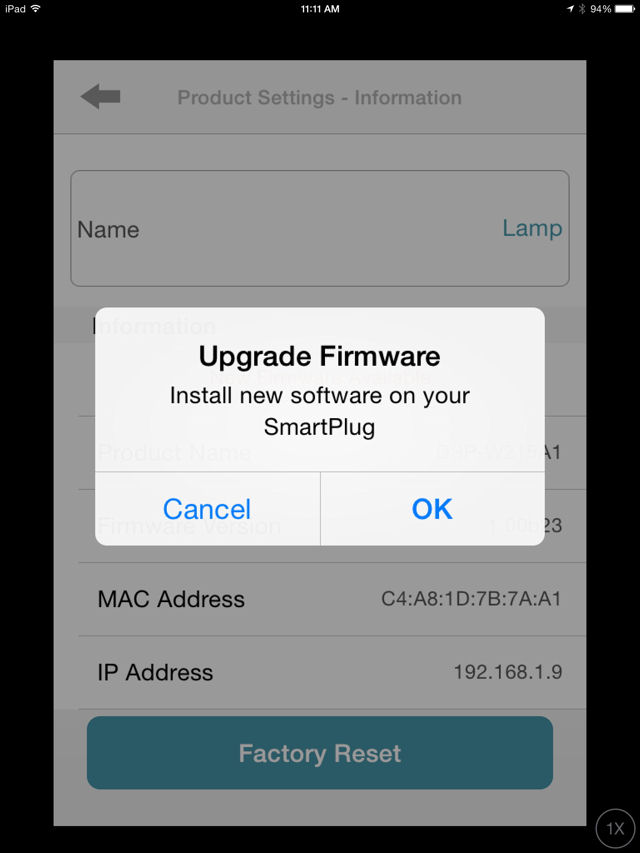
Tap on the notification to upgrade the firmware.
Initially, I had a problem during setup with the Smart Plug negotiating a WPS connection with my router. A power cycle of the router resolved that issue. I also set up the Smart Plug before I left on an extended trip. It worked fine, and I was able to connect to it, monitor power usage and change the status for about 10 days or so. Then it went offline. Upon returning home, I discovered that we had experienced a power outage and apparently the device didn’t come back on line when power was restored. I unplugged it, moved it to my office, plugged it back in again and it reconnected.
I tested both the iOS and Android apps. As noted, the iOS app is designed for the iPhone. Both apps worked the same and featured the same UI. Testing the Android app didn’t go as smoothly. When searching for the app on my Nexus 7, the Google Play store didn’t return a match. It would appear that there might be separate version for Android tablets that’s different than the version for Android phones. I experienced no problems with the Android app on my Razr Maxx.
When connecting remotely, you have the same access to the device as if you connected on the local network. The only difference I noticed was some additional latency due to a slow connection.
Closing Thoughts
Compared to my struggles with Belkin’s WeMo Insight, I had a much more positive experience with D-Link’s Wi-Fi Smart Plug. It was easy to set up, configure and use and worked well.
But as with all products, there’s room for improvement. Though not implemented properly on the WeMo, I liked the concept of a sunrise/sunset schedule that would change the schedule automatically. From a security standpoint, I would also have liked the option of randomizing an event around a scheduled time. When lights come on at exactly the same time every night, it’s sure sign to potential burglars that you’re not at home. Going back to the days of my old X10 controllers, I remember that it would randomize on/off times around a scheduled time for just that reason.
In a larger environment where you might have multiple devices, the ability to log on/off events to a syslog server, including manually changing the power state by pushing the power button on the device, could be attractive feature for those using the devices for security purposes. Finally, the lack of either desktop apps or a web browser interface on the Smart Plug may be seen as a negative by some potential users.
In the end, the D-Link DSP-W215 delivers the features it promises. It installed easily, monitored power and turned attached devices on/off on schedule. If you’re looking to wise up a plug or two around the house, I recommend the D-Link over the Belkin WeMo.
